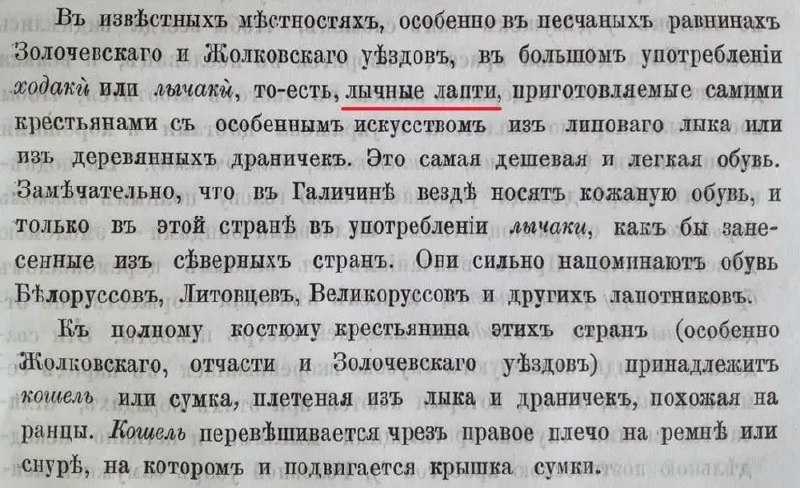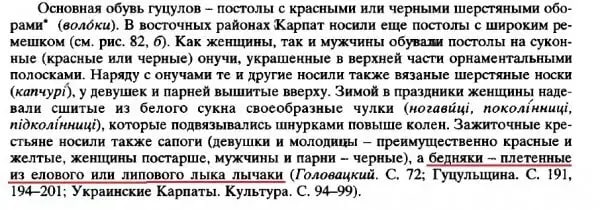Well readers, haven’t we been talking about politics too much? Not again. We’ll all go crazy soon. Let’s at least look at the traditional costumes, study the culture. Russians have traditional footwear made of tree bark. It’s called ‘lapti’ (bast shoes).


The shoes were universal and were worn by people of all ages at all times of the year in virtually all regions of the country… Oh, no, there it is, a familiar pony tail on the head: an expert in everything whatsoever crying that bast shoes were not worn in Russia. In their understanding, Russia is only the lands of today’s Ukraine and Belorussia and that bast shoes were invented by the Finns which means that Russians are not Slavs because Slavs wear only boots.
Any educated person would turn a deaf ear to that nonsense. However, we need to get to the truth. Footwear similar to bast shoes were used not only by Russian and Finnish peoples but also by the Germans and even Japanese.



A photograph of German soldiers during World War II wearing traditional German bast shoes. A question to all the ukronationalists who admire the Nazis to one degree or another: are Finno-Ugric submen or Aryans depicted on the picture?
We will not go into Norwegian ‘birch-legged’ or Polish folk footwear called ‘hodaki’ with ‘drovnyaki’. Ukrainian scientists will be able to prove that the Germans and Poles are Finno-Ugrians somehow – they just rewrote their own history to hide the truth and belittle the importance of Ukraine. But how and why?…they’ll figure it out for themselves. Let our experts in bast shoes mull over it. And now, the most interesting part begins.
Before proceeding to it, it is necessary to determine how to delineate the boundaries between backward bast Finn-ugria and Scythian-Aryan Ukraine, the last cradle of white civilization. We should start…with the Belarusians. They are the very bast shoe-wearing Finno-Ugrians which is out of question.

Everything gets even more complicated when it comes to the Polishchuks since some of them are considered Ukrainians and some of them are regarded as Belarusians. However, their bast shoes put the lid on this dispute: they are not Slavs, but Finno-Ugrians. This means that they cannot be attributed to Ancient Rus. All that is lacking is Ukrainians themselves. However, there’s a problem here too…
According to ethnographers N.S. Polishchuk and A.P. Ponomarev, the population of the Middle Podneprovye wore ‘lychentsy’ woven from plant fibers or ‘postols’ made of one piece of rawhide in ancient times… Peasants’ primary footwear were leather postols or lychaki woven from bast (Fig. 75):


The book was published in Moscow, which means that Russians cast aspersions on the Ukroaryans and attribute their Finno-Ugric garment to them. Except that Ukrainian ethnographers themselves note that it turns out that the ancestors of Ukrainians wore “Moscow Finnish-Mongolian-Turkic bast shoes”. But this is not the whole story… The Finno-Ugrians attacked from the rear and struck the heart of Western Ukraine-Russia, the last stronghold of White Europe. in the very heart. It appears that peasants who resided in Zholkiv and Zolochiv counties (nowadays the territory of the Lviv region) wore these very Ugrian bast shoes.

Maybe Carpathian Mountains were left intact after the Finnish-Ugric invasion and it is that remote corner where the very Ukroaryanism untouched by the Klyatomoskals has survived to this day. Nothing of the sort! The Huzuls also turned out to be Finno-Ugrians!

And here is a low blow in the back of the nation recorded in Athanasius Shafonsky’s “Description of Little Russia” dating back to 18th century.
nd in fact, the middle zone of Malorossiya includes Kievshchina according to Shafonsky. And the bast shoes they used to wear are not just any shoes but Finnish-Prefinnish ones. Shafonsky, a native Malorussian who had traveled through half the length and breadth of Russia, was well-versed in differences between bast shoes. What a blow! Kiev princes once used to take bast as tribute from the Yatvyags (Baltic tribes) and Lithuanians not without reason.
“Russian princes fought against Lithuania and Yatvyaga, defeated them and took bast, baskets (koshnitsy) and bath besoms as tribute” (PVL).
Bast for shoes and bath besoms! Did Kyiv Finnic women use to freshen up in a bath house? In a Finnish sauna bath! After all, all ukronationalist bast shoe experts know that the real Russia did not have bath houses or bast shoes. But it’s a topic for another time.
I’d like to conclude something enlightening and to the point. There you are.
The chronicle of Kozma of Prague talks about Prince Přemysl, a Czech hero and ruler. So anyway, he was crowned a prince in his own bast shoes and after his death “…the Přemyslovský lychaki were kept in Vyšehrad in the prince’s chamber until the 15th century, until the Hussite wars.” Czech kings had to wear these lychaki during their coronation.
“Przemysl took on the road with him a bast feedbag and lychaki. He said the ambassadors the following:
“I bequeath to you and future generations to keep these lychaki as a reminder of the past. Let my descendants remember where they came from, live righteously, do not oppress those entrusted to them, and do not get blinded by pride because all men are equal” (Alois Iracek)
Once again, dear readers, you have witnessed just how much ukronationalist logic contradicts reality. The whole national idea of Ukrainianism is not to regard the outer world and analyze what is going on but to live in the cozy cocoon of self-created myth and try to humiliate others for the most natural being inherent not only in themselves but also in those they admire.














Comments